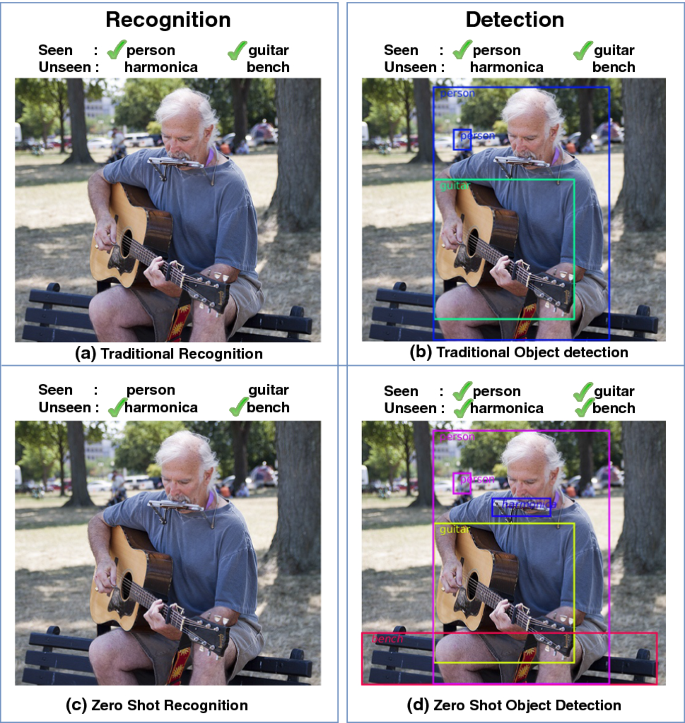Artificial Intelligence (AI) has made significant progress, with computer vision being a key subfield. Object detection, a critical component of computer vision, has numerous applications, from self-driving cars to medical diagnosis. In this article, we will explore the cutting-edge field of Zero-Shot and Few-Shot Object Detection, examining recent research and considering the potential impact on industries and the global economy.
Understanding Zero-Shot Object Detection
Training a machine learning model is similar to teaching a student. Traditional object detection models need extensive training to recognize a set of objects. In contrast, Zero-Shot Object Detection (ZSD) models can identify objects they have never seen during training. This makes them very flexible in adapting to new objects and situations without needing retraining.

Grounding DINO: A Leading Framework in Zero-Shot Object Detection
As of March 2023, the Grounding DINO model is a leader in Zero-Shot Object Detection. The model has achieved impressive performance, setting new standards in the field.
Key features of Grounding DINO:
-
Referring Expression Comprehension (REC): Allows the model to accurately locate objects or regions in an image based on text descriptions. The model must be able to understand both language and visual inputs and combine them effectively.
-
No Hand-Designed Components: Grounding DINO avoids the need for time-consuming hand-designed components like Non-Maximum Suppression (NMS), which simplifies the architecture and improves performance and efficiency.

Grounding DINO’s architecture combines ideas from the DINO and GLIP papers. It uses a text backbone like BERT for processing text features and an image backbone like the Swin Transformer for visual features. These are then combined in a cross-modality feature enhancer, creating an architecture that is both flexible and strong, ready to tackle various real-world problems.
Introducing Few-Shot Object Detection
Few-Shot Object Detection (FSD) involves training models to recognize objects with very few examples. This is useful when creating large datasets is not practical or too expensive.
New Developments: Few-Shot Object Detection via Online Inferential Calibration
Few-Shot Object Detection via Online Inferential Calibration (FSOIC) is a notable development in FSD. It addresses the challenges of overfitting, misdetection, and limited samples through a two-stage fine-tuning process. FSOIC uses an Attention-FPN network that combines features by creating links between channels, helping the Region Proposal Network (RPN) efficiently extract key features of new object classes. Along with a hierarchical learning method and an online calibration module, this system effectively encodes and segments samples, improves object scores, and fixes misclassifications. Tests show that FSOIC is a major step forward in Few-Shot Object Detection.

Potential Impact: Changes in Industries and the Economy
The progress in Zero-Shot and Few-Shot Object Detection could have major effects on industries and the global economy:
-
Efficiency and Flexibility: With ZSD models like Grounding DINO, industries can quickly adapt their object detection systems to new objects without extensive retraining, improving efficiency.
-
Quick Response to Change: The flexibility of ZSD and FSD models is very useful in fast-changing industries like e-commerce and cybersecurity, where being able to respond quickly to changes is important.
-
Improved Accuracy: As models like Grounding DINO and FSOIC continue to improve, systems that rely on object detection will become more reliable and precise, which is essential in applications like self-driving vehicles and healthcare.
-
Economic Growth: These models could lead to innovation in many sectors, such as manufacturing, healthcare, and logistics, potentially driving economic growth.
-
Customization and Personalization: The ability of these models to understand text descriptions and link them with visual elements could enable new levels of customization and personalization in products and services.
Future Opportunities and Challenges
As AI research continues to advance, Zero-Shot and Few-Shot Object Detection are becoming key technologies. These methods are expected to keep improving and expanding.
Organizations developing AI solutions should consider adding the latest Zero-Shot and Few-Shot Object Detection models to their offerings to stay at the leading edge of innovation. At the same time, researchers need to work on addressing remaining challenges, like handling complex scenes and optimizing real-time performance.
Conclusion
In summary, Zero-Shot and Few-Shot Object Detection technologies represent major advancements in object detection and AI. Their ability to adapt to new objects and situations with little data marks a significant change for many industries. As these technologies continue to develop, they are likely to have a lasting impact on our lives and the global economy.
Stay tuned for more insights into the evolving field of AI and object detection.